It is obvious from the onset of Tom LaDuke’s recent exhibition that one is in the presence of the repressed. The appearance of the repressed should always be hailed as a brief return of the long lost. This reunion takes the form of recollection, a calling back to mind, a gathering together again of details that had been forgotten. And yet, as is the wont of the repressed, nothing in the story it tells us is so baldly recounted. Some things remain unspoken, some details skimmed over. And more often than not, the repressed slips away again before we have an opportunity to quiz it about what has been omitted.
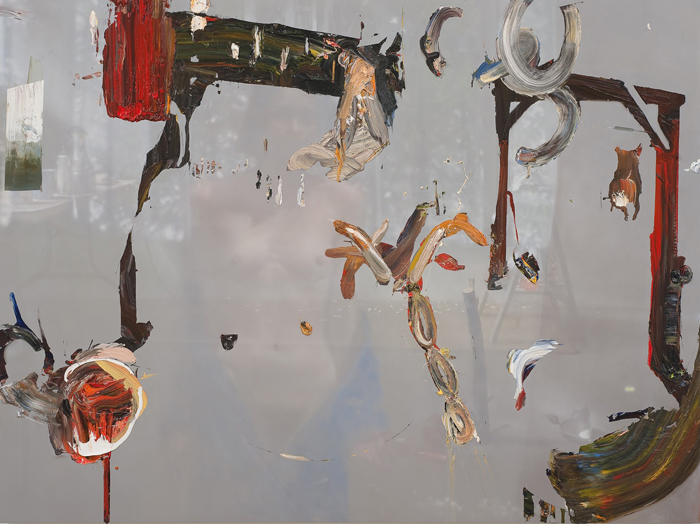
Tom Laduke, Auto Destruct, 2009. 0il and acrylic on canvas over panel, 60 x 80 in. Courtesy of the artist and Angles Gallery.
In Auto Destruct, LaDuke’s dark, narrative paintings present layered scenes in which imagery surfaces and materializes briefly as we direct attention to it, only to become subliminal again when we focus elsewhere.1 In each canvas are at least three layers, one superimposed upon the other. LaDuke brings together appropriated film stills with images of his studio and art historical masterpieces. Both the filmic “ground” and the intermediate layers, derived from photographs taken of his studio, are laid down in muted hues of transparent, airbrushed acrylic. Optically, the filmic and studio layers intermingle yet vie for preferential treatment, although typically the filmic wins out. Perhaps this is because the ratios of the paintings approximate those of film and television screens and so we see them more readily. Or more likely, we have viewed these images before, either in the films themselves or reproduced as stills. Because they are already lodged in our memory, the filmic imagery passes a kind of “truthfulness” test. Meanwhile, the art historical source material sits heavily on top of the paintings’ surfaces, rendered piecemeal in thickly applied oil paint. Almost utterly reduced to scattered, expressionistic blobs that for the most part refuse to coalesce into a recognizable image, the masterpieces passively nag at us to “re-member” them.
Most of LaDuke’s filmic and historic painting references are accessible on the Internet should the viewer wish to confirm any hunches about them. However, a close reading of all visual quotations is unnecessary, even detrimentally reductive, to the new narratives established in his paintings. Everything that one really needs to know about the works can already be read in them: a critique of painting as a practice, the ever-present Platonic indictment of vision as an illusory and deceptive faculty, and equally, LaDuke’s more ominous treatise on sexuality, coupled as it is with the tension of potential violence that can permeate any such unveiling.
Other reviewers have commented upon LaDuke’s indebtedness to the aesthetics and techniques of Gerhard Richter and Sigmar Polke. However, in LaDuke’s works one can imagine too that Marcel Duchamp’s bachelor from The Bride Stripped Bare by Her Bachelors, Even (The Large Glass) (1915-1923) is not far, grinding away in a state of olfactory masturbation.2 Duchamp meant for the transparency of The Large Glass to in part rebut the act of painting; in his typically smart-alecky way, he shows viewers how simple it is to see “through it all.” Similarly (although much more sincerely), LaDuke’s use of transparency invites us to see through his endeavors here.
The technique of airbrushing allows for remarkable precision and cleanliness in tonal gradation, but ultimately its visual effect is one of fuzziness. In this sense, airbrushing evokes memory, wherein the central aspects of an event are retained with great detail in the mind’s eye, while lesser aspects frequently blur or leach into the background. The soft focus of airbrush, combined with LaDuke’s hazy palette, lends a distinctly oneiric quality to his paintings, which is an idea that is reinforced by his appropriation of film stills. Since practically the beginning of cinema, psychologists and film theorists have related the experience of film viewing phenomenologically and symbolically to the act of dreaming, and, by extension, to the workings of the unconscious.3 By subjecting the images of his studio to the same visual treatment as the filmic layers, LaDuke seems to insist that his practice too is a variety of Traumarbeit (dream-work).4
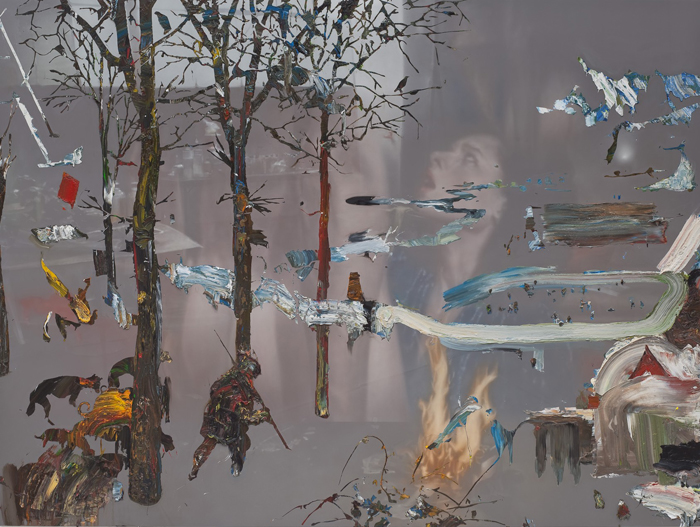
Tom Laduke, You’re Like Me, 2010. Oil and acrylic on canvas over panel, 75 x 100 in. Courtesy of the artist and Angles Gallery.
When he documented his studio space in painting series executed in 2007 and 2008, LaDuke captured it “as is.” For Auto Destruct, he gave himself permission to engage in a process of free association in order to intuitively arrange old or unresolved artworks, tools, furniture, and the usual assorted junk of the studio into still lifes. Unexpected compositional elements such as inflated balloons have been cryptically inserted into his tableaux. LaDuke indulged in other, riskier impulses as well. For the work You’re Like Me (2010), he was inspired to set fire to a pile of art-making debris in the middle of his studio floor and had to work quickly to get his shot before the blaze got out of hand.5
As a hallmark of surrealism, artistic free association received its inspiration from Andre Breton’s reading of Sigmund Freud’s The Interpretation of Dreams (Die Traumdeutung, 1900). Through “automatic writing,” the surrealists sought to unleash the unconscious from the strictures of the rational mind in the service of creativity. LaDuke certainly follows in this lineage. Indeed, his presence is deeply felt inside the frame of his paintings. Coupled with direct reference to his studio practice and its “dream-like” representation through the technique of airbrushing, LaDuke’s deployment of free association encourages the viewer to perceive the narratives of this layer as a form of occulted self-portraiture. Even though it is highly fragmented, the art historical layer at the painting’s surface is the most “real,” in all connotations of the term, due in part to LaDuke’s thick, sensual application of paint. The artworks are redolent with the odor of oil paint, the scent of which brings us into the present moment, making us conscious of their objecthood; but it can also send us back, perhaps even as far as our erotic first encounter with the pungent art material. In this, we too have something of Duchamp’s cocoa grinder in us.6 In marked contrast to the tight control he exhibited in the airbrushed layers, LaDuke’s brushwork here is glutinous and his colors loosely applied. At the same time, the surface layer exhibits a peculiarly circumspect quality in spite of its exaggerated gesturalism. In part, this is caused by technique, as LaDuke blocked out the rest of each canvas with a stencil in preparation for the application of the oils. But the visual effect also suggests that we are meant to read this layer as if it were somehow bracketed.
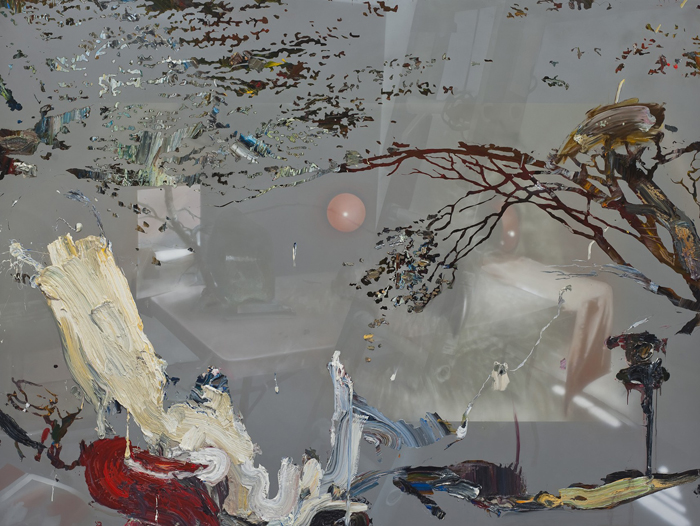
Tom Laduke, A Gothic Plot, 2009. Oil and acrylic on canvas over panel, 60 x 80 in. courtesy of the artist and Angles Gallery.
References to the primal scene (the first episode of sexual intercourse witnessed by a child) surface and resurface in Auto Destruct. In the titular canvas (2009) is an abstracted, daisy chain of looped wieners—ever so phallic and yonic at the same time—which LaDuke has taken from Pieter Aertsen’s Butcher’s Stall (1568). The menacing aura of the primal scene is there too in the morose, redacted details of the stall’s rudimentary architecture, which is made by LaDuke to look like a gallows. In A Gothic Plot (2009), LaDuke appropriates Caspar David Friedrich’s Chalk Cliffs of Ruegen (1818) to set the stage. In the original Friedrich, a leafy tree branch penetrates a distant Baltic Sea that is depicted as being beyond a threatening maw of pale, almost flesh-colored chalk palisades. Depicted by Friedrich at the scale of small children, a honeymooning couple and their companion look out upon the dramatic scenery from the foreground. Were we in the presence of the actual Chalk Cliffs of Ruegen, we would be watching them watch, redoubling the tension of the primal narrative in which no one wants to get caught looking. In LaDuke’s appropriation, they are all there, if reduced to goopy brushstrokes: the tree, the sea, the maw, and the children.
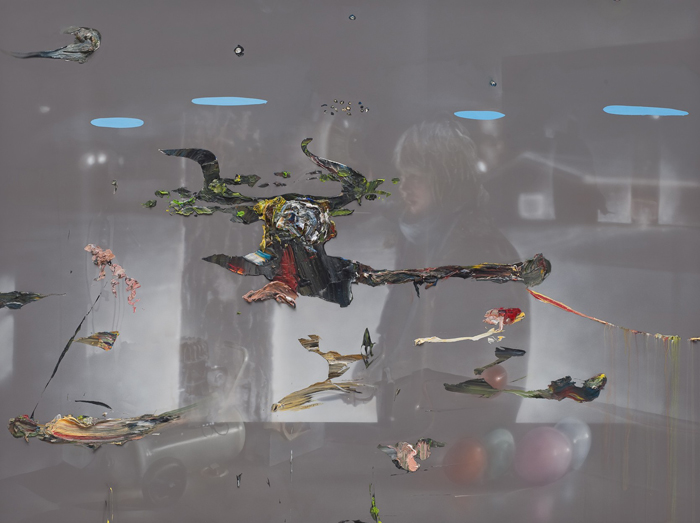
Tom Laduke, Young Love, 2010. Oil and acrylic on canvas over panel, 45 x 60 in. Courtesy of the artist and Angles Gallery.
As a manifestation of power, the phallus is a recurring element in the paintings, although it appears to be under duress. In You’re Like Me, LaDuke chose a key scene from Blue Velvet (1986) in which the seemingly dominant Jeffrey stands before a kneeling Dorothy as she prepares to fellate him. In fact, the power relationship is reversed, as Dorothy holds an unseen knife to Jeffrey’s genitals. In LaDuke’s Young Love (2010), a murderous and love-struck pre-adolescent from the vampire movie Let the Right One In (2008) rises up through the under-painting, surfacing to point yet another knife at the crotch of Satan himself, as manifested in the goat-like Baphomet from Goya’s Witches’ Sabbath (1798). In both compositions, the organ itself is conspicuously absent, and perhaps this omission of the phallus signals some latent crisis of authority.
Scintillating as all this is–between the superabundance of things we shouldn’t be looking at and the things that are not present but should be–the viewer is compelled to look yet further. Psychologists have long maintained that in the case of traumatic early childhood memories, not all of what we gather is ever put back in its proper place. Instead, insignificant details may come to the fore. Freud called such recollections “screen memories,” the role of which is to support “retroactively projected fantasies.”7 He believed screen memories are symptomatic of a psychic compromise between repression and defense, the prominent mechanism of which is displacement. Screen memories arise when an excessive external stimulus “wounds” or “breaches” our protective psychic shield.8 They work to cover a gap made by the trauma, which is of such severity that it cannot be coped with “by the usual mechanisms by which we deal with pain or loss.”9 It hardly seems coincidental that, in describing the visual operation of his paintings in Auto Destruct, LaDuke has referred to the fragmentary top layer as a “breach in the continuity.”10 It is as if a screen of the “nobler virtues” of art making has come entirely undone for him, exposing the dirtier motivations that underlie it for all to see.
As pointed out by Jacqueline Rose in the essay “Sexuality in the Field of Vision,” Freud often related sexuality to visual representation, and his narratives stress a “problem of seeing.”11 In the case of the primal scene, a trauma par excellence, this problem in seeing has less to do with what is seen and more to do with the subjectivity of its young witness and his own developing, internal self-narrative of sexual identity. Either the child refuses to believe the anatomical differences that have been revealed, or the “pleasure in looking” is too much–pushing into a “register of excess” that the child attempts to interrupt by calling attention to his presence.12 As it plays out, Rose says the relationship between viewer and scene is “always one of fracture, partial identification, pleasure and distrust.” She goes on to make the comment that it is as if “Freud found the aptest analogy for the problem of our identity as human subjects in failures of vision or in the violence which can be done to an image as it offers itself to view.”13
Rose wrote “Sexuality in the Field of Vision” in the mid-1980s to address the prevalent artistic themes of sexual politics. Reconfigured as “theoretical prototypes,” the sexual was staged by artists of the era to “expose the fixed nature of sexual identity as a fantasy and, in the same gesture, to trouble, to break up, or rupture the visual field before our eyes.”14 The paintings of Auto Destruct certainly operate in this manner. By engaging with LaDuke’s artworks on their terms, we project ourselves into his re-presented crisis of sexual identity.
However, more relevant to LaDuke’s paintings is Rose’s brief plea for reinstating repetition’s “proper meaning and status.” To her, the significance of repetition lies not in a “lack of originality or something merely derived nor the more recent practice of appropriating artistic and photographic images in order to undermine their previous status.”15 Rather, repetition is an “insistence,” a “constant pressure of something hidden but not forgotten–something that can only come into focus now by blurring the field of representation where our normal forms of self-recognition take place.”16
In Auto Destruct, LaDuke’s approach is distinctly repetitive. Not only do the layers of his paintings adhere to a rigid formal structure, but a thematic chain of associations that LaDuke is continually making appears through his use of quotations, both in the filmic and art historical layers. His subplots appear to do with conceptions of love, be they filial, brotherly, conjugal, unrequited, perverse, lost, gone south, or some combination thereof. Whether the aspect of love under consideration in a particular canvas might be deemed pleasurable or unpleasurable, it is laden with the very same tension as is manifested in the other paintings. And LaDuke, calling attention to his presence through the studio still lifes, is always caught in the middle.
Freud examined repetition in his classic and wide-ranging text Beyond the Pleasure Principle (1920). Although he begins by discussing the “traumatic neuroses” of veterans reliving the horrors of World War I,Freud is soon talking about that little boywith his reel on a string, cheerfully playing the game of fort-da (gone-there), rehearsing the disappearance and reappearance of his mother in order to master anxiety about abandonment that her absence instills in him.While fort-da was ultimately salutary for the toddler, Freud puzzles through this child’s play to seek out the source of his other patients’ far less healthy compulsions to re-enact events that were categorically unpleasurable.The existence of such neuroses overturned prevalent theories of the day in which the unconscious ego was assumed to operate under the sway of a “pleasure principle.”Freud believed no satisfaction could ever come from the compulsion to repeat, not even for instinctual impulses that have long been repressed.17
In a passage in which he discusses the relationship between repetition and the universal characteristics of instincts, Freud asserts that an instinct is “an urge inherent in organic life to restore an earlier state of things.”18 Expanding upon this idea through an examination of biological lifecycles, Freud ultimately concludes, “The aim of all life is death.”19 Interestingly, Freud also speculates that an organism “wishes to die only in its own fashion” and consequently makes “ever more complicated dEtours before reaching its aim of death.”20 The delay of the death drive is brought about by the reconciliatory nature of eros (the whole of the life instinct, of which the sexual drive is but one part). It is eros that Freud has in mind when he claims that the life of any organism moves with a “vacillating rhythm”:
One group of instincts rushes forward so as to reach the final aim of life as swiftly as possible; but when a particular stage in the advance has been reached, the other group jerks back to a certain point to make a fresh start and so prolong thejourney.21
In his essay, “Freud’s Masterplot,” literary critic Peter Brooks identifies Beyond the Pleasure Principle as a “theory of the very narratability of life.”22 He identifies Freud’s essay as a meta-text about the development of plotlines, since narrative “always makes the implicit claim to be in a state of repetition, as a going over again of a ground already covered.”23 And yet, in Brooks’s estimation, the very possibility for narrative depends upon the “anticipated structuring force of the ending,” as otherwise, the “interminable would be the meaningless.”24 While the death instinct is at operation in the text, the repetitions of plot, “beyond and under the domination of the pleasure principle,” provide “pulsation.”25 Further, the terms of backward and forward become reversible in textual repetition, as the end becomes “a time before the beginning.”26
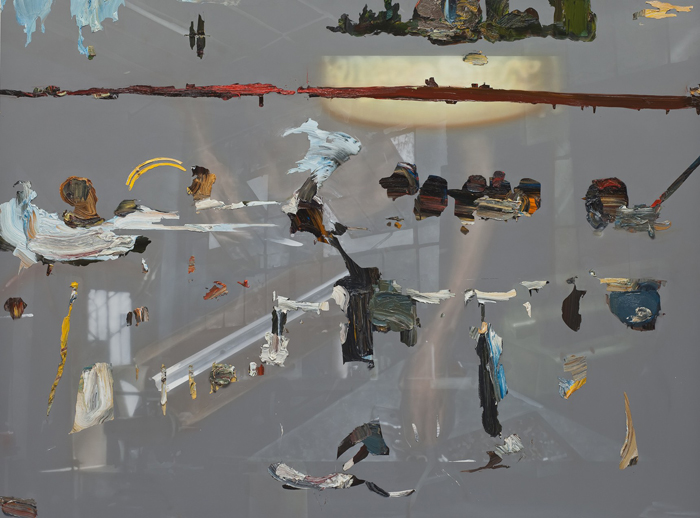
Tom Laduke, Here is, 2009. Oil and acrylic on canvas over panel, 60 x 80 in. Courtesy of the artist and Angles Gallery.
In keeping with this trajectory, Brooks describes plot as a “kind of arabesque or squiggle toward the end.”27 It is “arbitrary,””transgressive,” and “gratuitous” in its deviation from the “straight line, the shortest distance between beginning and end.”28 As such, it stands for a kind “postponement of the discharge which leads back to the inanimate.”29 Having been drawn in by a story’s plot, the involved reader becomes subject to a vacillating rhythm of anxiety experienced as pleasure. For the end of a story is also, as Brooks puts it, the “moment of the death of the reader in the text.”30 Artists exploit the same kind of narrative deviations to successfully postpone the epiphanic discharge in any viewing experience. This is the artwork’s “play” and we the viewers want to “play along.” Certainly, the most disappointing viewing experience is one in which we “get” an artwork right away because in a sense it is already dead to us.
When LaDuke restages his narratives of trauma in various guises in the aptly entitled Auto Destruct, it seems that it is not the “little death” that really concerns him but the bigone. But the tug of eros brings him back, again and again. This notion is reinforced formally in the optical vacillations of imagery from underpainting to surface and back. It is there, too, in the thematic undercurrent of love that tempers the primal aggression of the sexual. LaDuke’s repetitions are where the satisfying tension of the paintings resides. In this respect, his postponements give new (or, really, old) meaning to the phrase “fucking around” as a kind of arabesque for both him and the paintings’ viewers.
Kristina Newhouse is an independent curator who lives in Tujunga. She has been active member of the X-TRA editorial board since 2003.
